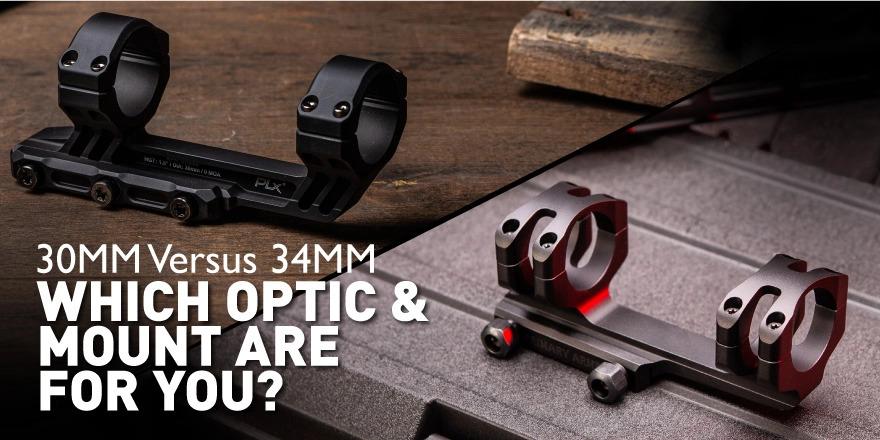
We live in a golden age of firearm optics. No matter what type of scope you’re looking for, you can choose from dozens of makers and hundreds of models, not to mention the plethora of reticles, features, and accessories. To make an informed decision, you need to understand what those different options mean and how they ultimately affect the performance of your scope.

One of the least understood facets of riflescopes is tube diameter. It’s the subject of many myths and misunderstandings, which tends to muddy the water a bit. Below, we’ll look at the facts, how they impact your capabilities, and how to choose the best optic and mount for you.
30mm Vs. 34mm: The Differences
When you see a scope listed as “30mm” or “34mm,” they’re referring to the size of the main tube. There are other sizes as well, such as 1-inch and 35mm tubes, but for the purposes of this article, we’ll stick to the first two. The measurement comes from the external dimensions, so it’s worth bearing in mind that internal diameter may vary between manufacturers or models.
The primary difference between the two main tubes is obvious: one is larger than the other. The actual significance of that can vary considerably depending on how the manufacturer uses that extra space.
In some cases, manufacturers will “size up” a design to 34mm by thickening the wall of the main tube, keeping the internal diameter the same. This results in a scope that is optically identical to a 30mm, but with much greater rigidity. This is most commonly done on scopes designed specifically for high-recoil rifles, such as those chambered in .50 BMG. In most cases, though, a 34mm tube will have a larger interior diameter than a 30mm tube.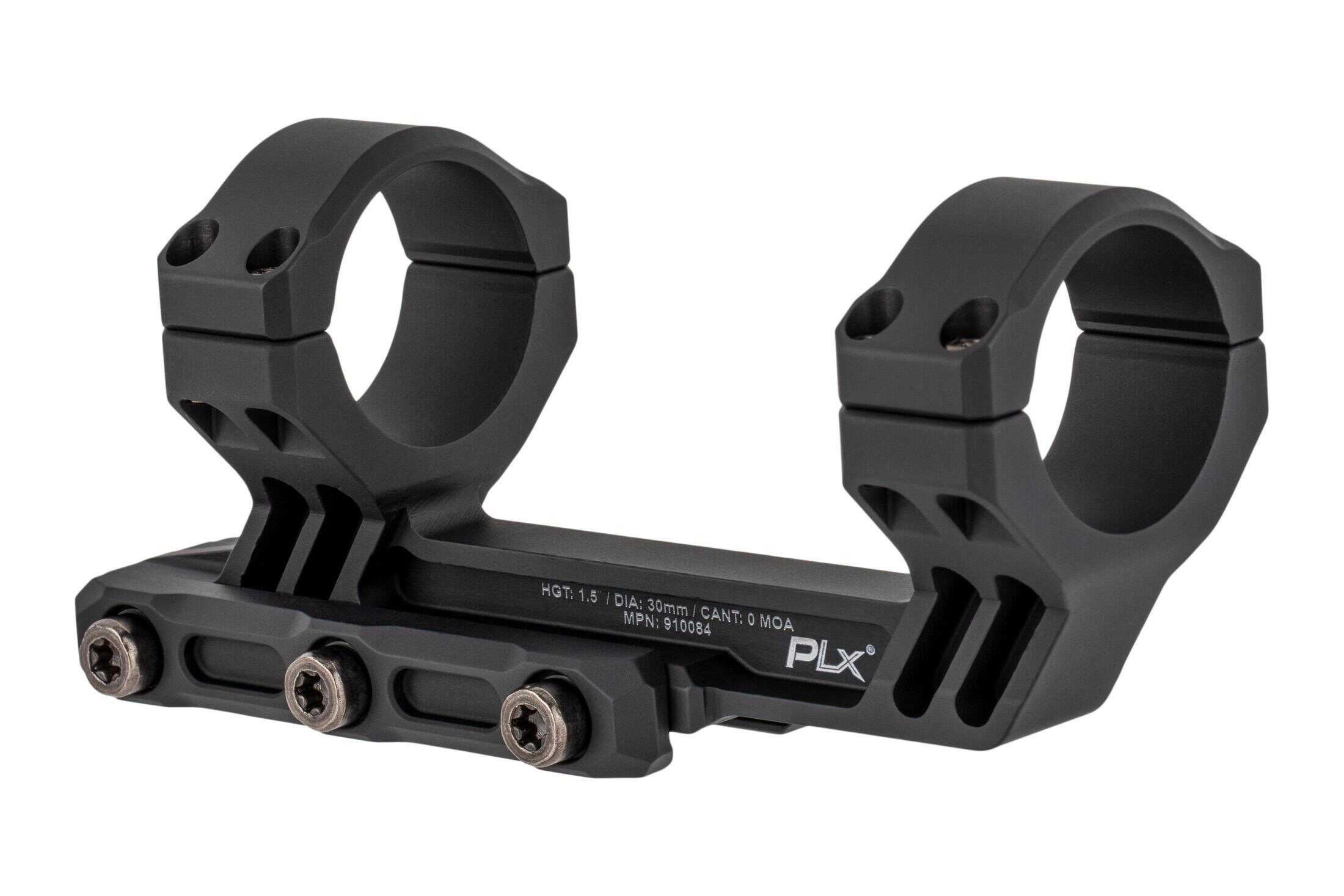
Buy Now
Before we get into how that affects performance, let’s dispel one of the most common misconceptions: larger main tubes do not directly increase light transmission or create a brighter picture. It’s a common myth, which likely stems from the idea that a larger tube should be able to fit more light through it, but it’s an incorrect one.
The amount of light transmitted by the scope is primarily determined by the objective lens. This is the lens at the front of the scope, facing the target.
The simplest way to understand objective diameter is to imagine a funnel collecting rain. The wider the funnel, the more rain will fall into it, and the stronger the stream of water running out the narrow end will be. Objective lenses work the same way.
In a funnel, the size of the narrow neck of the funnel has no impact on the volume of water flowing through it, just as the scope’s tube diameter has no effect on the amount of light transmitted.
However, there is a caveat to this. While larger main tubes do not directly improve light transmission, they can indirectly support it by allowing a larger objective lens. The difference is subtle but important; if you want the brightest image possible, a 34mm scope might be the way to go, but if you’re deciding between two scopes with the same size objective lens, don’t assume that the larger main tube will be brighter.
The main benefit of a 34mm tube diameter is a wider elevation adjustment range, as the erector assembly has more room to move before contacting the tube wall. Elevation adjustment range is essential for long-range precision shooting, as it determines your optic’s effective range. If you can’t adjust far enough for the distance, you’ll have to rely on your reticle stadia to estimate your holdover.
Shop All In-Stock 34mm scope mounts
Buy Now
Both 30mm and 34mm optics can increase their adjustment range by using a canted mount or base, but 34mm optics are generally considered superior for truly long-range shooting due to their overall great adjustment range.
The main downside to 34mm tubes is weight. Larger tubes, larger lenses, and often more robust erector assemblies add up to more weight. Of course, there are exceptions to this rule, but most users will usually find that 34mm scopes weigh more.
This is compounded by the fact that 34mm mounts are, on average, heavier than their 30mm counterparts. This is partly due to the larger size, but it also comes from purpose. Since 34mm scopes are better at long-range, most heavy-duty precision mounts are designed around a 34mm diameter, and most long-range marksmen will happily trade a few ounces if it means slightly more accuracy downrange.

30mm: Best Applications
30mm scopes are the jack-of-all-trades of the optics world; there are not many applications they’re not good for. For that reason, they’re often considered the standard for scope tube size.
This main tube size is ideal if you’re looking to save weight on your rifle. If you’re going to be carrying your gun through the woods all day on a hunting trip, only to take a shot at less than 200 yards, then the increased adjustment offered by a 34mm scope would be wasted, and the extra weight is unwarranted.
30mm main tubes are also usually the best choice for LPVOs. A 30mm tube will give you more choices for mounts and accessories, and LPVOs lack the magnification necessary to engage targets at ranges beyond the limit of their adjustment. There’s one exception to this maxim, which we’ll discuss momentarily.
In general, unless you have a particular reason to want a 34mm optic, 30mm is the default choice.

34mm: Best Applications
34mm scopes hit their stride in two distinctly different types of scopes: long-range precision optics and LPVOs with high magnification ratios.
They can be an excellent choice for long-range precision because of the increased reticle adjustment, allowing users to stretch their rifles to further targets before running out of adjustment, especially when combined with a canted mount.
On the opposite end of the spectrum, a 34mm main tube can also be beneficial in a low-power variable optic—especially those with 1-8x or 1-10x magnification ranges. Since LPVOs generally do not feature a belled section at the objective end of the tube, the objective lens diameter is limited by the tube diameter. In this case, a larger main tube allows you to use a larger objective lens, delivering a brighter, clearer picture with a more forgiving eyebox.

30mm: Best Scope Mounts
30mm mounts are as diverse as the scopes themselves, with a smorgasbord of different designs optimized for different applications.
Choosing the best 30mm scope mount would be a lot like choosing the best tool in your garage. Some do certain tasks better than others, but at the end of the day, a wrench isn’t better than a hammer—they’re just different. The important thing isn’t having the best tool—it’s having the one that is best suited for the job at hand.
If you choose a lightweight LPVO for your rifle, you probably want a lightweight mount to go with it. For an AR-15, you will probably want a cantilever mount, as it will allow for an ideal eye position. Depending on your application, you may look for other features, such as built-in scope level or offset reflex mounts.
On the other hand, if you’re mounting a 6-24x on a 6.5 Creedmoor bolt gun, you’ll almost certainly want a straight mount rather than a cantilevered one. It’ll also probably be quite a bit shorter than the LPVO mount since precision rifles usually have their scopes mounted as close to the barrel as possible. Scope leveling features may still be a plus, but the ability to mount a red dot might not be as important if you shoot benchrest.
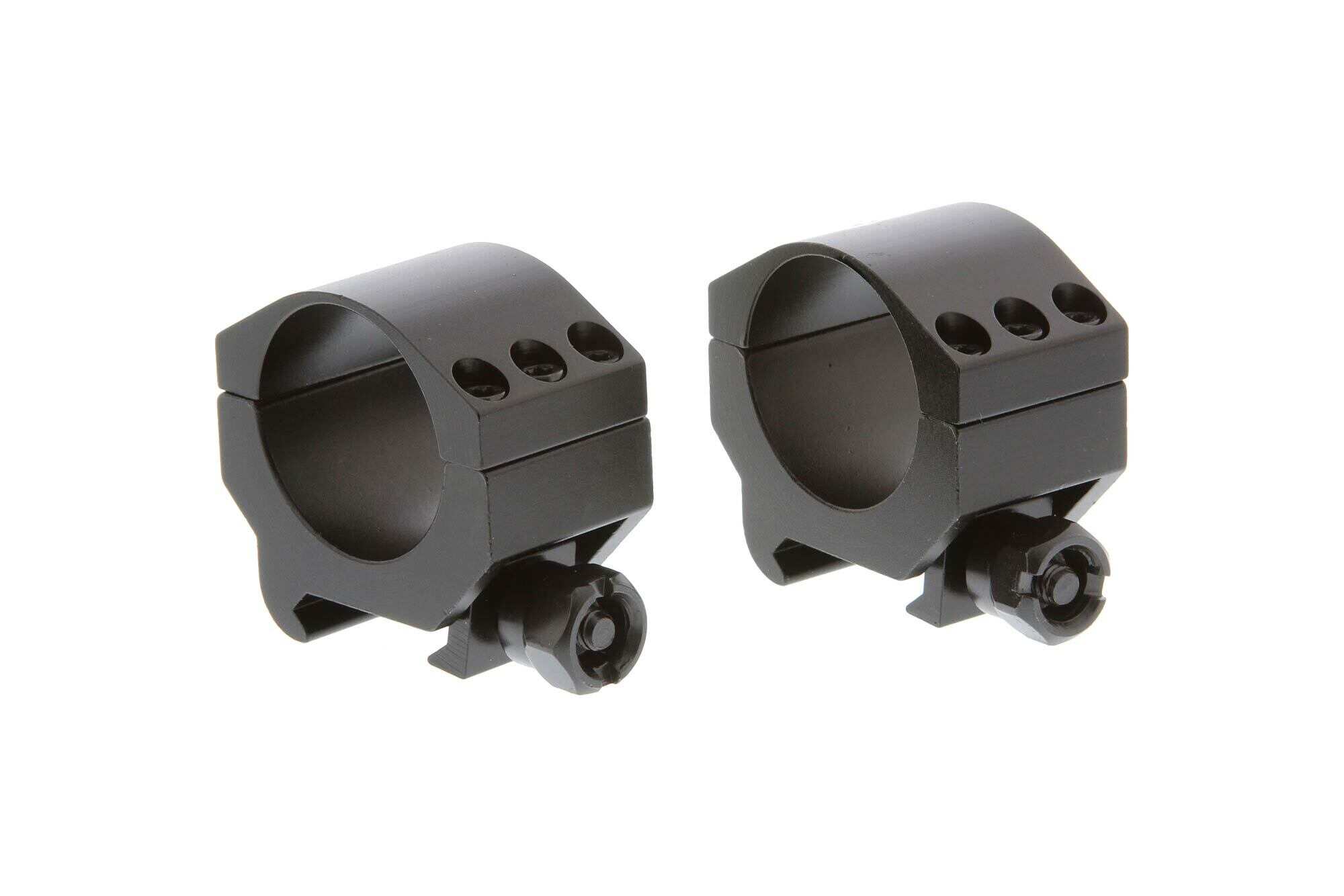
Shop All In-Stock Scope Rings
Buy Now
With precision rifles and bolt-action guns, it’s worth considering traditional scope rings as well. Rings are generally unsuitable for use on AR-15s and similar rifles since they can’t provide cantilevered mounting as well as a one-piece mount, but they can be beneficial for bolt-actions. Rings are often available in a wider variety of heights, which can be useful if trying to mount your scope as low as possible to the action.
Rings are generally lighter than one-piece mounts but typically will lack any additional features. You won’t often find anti-cant levels or mounting tools built into rings. For rifles with open actions and internal magazines, though, such as the venerable Remington 700, opting for split rings over a one-piece mount can allow for more clearance when loading rounds.
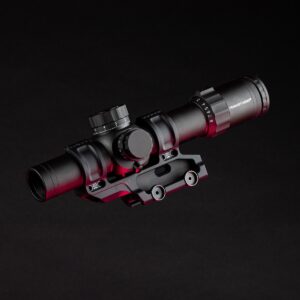
34mm: Best Scope Mounts
As with 34mm scopes, the best mounts fall into two very different categories.
If your chosen 34mm scope is a long-range optic for extreme distances, you’ll need a very strong, rigid mount to hold it; this is especially true when shooting hard-recoiling calibers like .300 Remington Ultra Magnum. You’ll probably want a straight mount, although certain cantilevered mounts, such as our PLx mount, can still provide the necessary rigidity to support these large scopes.
Rings may be a viable alternative here as well, depending on your rifle and application. Similar to their 30mm counterparts, 34mm rings will usually be lighter than 34mm one-piece mounts due to the reduced amount of overall material. However, they are generally less feature-rich. Ultimately, the choice between rings and mounts comes down largely to personal preference.
While the ability to mount an offset or piggyback red dot may not be critical on a precision rifle, some users may find value in the ability to mount a laser rangefinder or IR unit to their scope. Similarly, a built-in bubble level can be helpful for minimalist users, while others prefer a more robust standalone anti-cant device.
For 34mm LPVOs, most users will be best served by a cantilever mount, although certain rifles with monolithic rails can achieve proper eye relief with a straight mount. Weight-conscious users will favor a lighter mount to offset some weight from their scope.
Beyond that, the choice of mount largely comes down to personal preference. Night vision users should seek mounts that accommodate piggyback red dots for passive aiming. Some competition shooters may favor mounts with the option to add an offset dot instead.
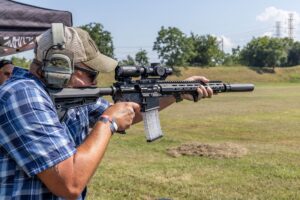
Summary
In the end, there’s no wrong choice between 30mm and 34mm scopes. The most important thing is to select the optic that is best for you and your application. 30mm main tubes are generally considered to be the standard, and with good reason. They’re an excellent option for most common use cases.
On the other hand, if you’re building a long-range precision rifle to hit targets beyond a thousand yards, the increased adjustment offered by a larger main tube may be invaluable.



